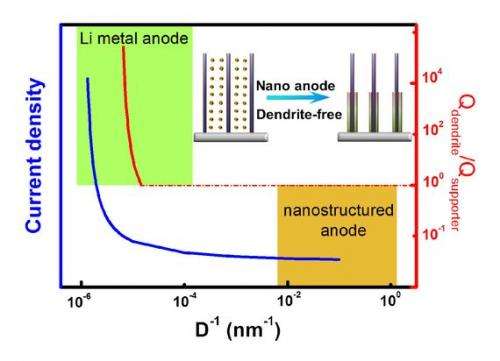Nanostructure enlightening dendrite-free metal anode

Graphite anodes have been widely used for lithium ion batteries (LIBs) during the past two decades. The replacement of metallic lithium with graphite enables safe and highly efficient operation of LIBs, however, significantly sacrificing specific capacity and energy density. In fact, as the "Holy Grail" of lithium batteries, lithium metal anodes exhibit a very high theoretical specific capacity of 3860 mAh g−1 and the lowest negative redox potential of −3.040 V vs. standard hydrogen electrode. However, the lithium dendrites forming and elongating during cycling may pierce the polymer separator, resulting in a short circuit and subsequent battery thermal runaway.
'The dendrites are mainly induced by inhomogeneous distribution of both current density on the lithium anode and the concentration gradient of lithium ions at the electrolyte/electrode interface,' explained Dr. Qiang Zhang at Department of Chemical Engineering, Tsinghua University in Beijing, 'the dendrite formation and growth will be retarded if the stability and uniformity of the interfaces between electrolytes and lithium electrode are improved'.
Qiang also mentioned conventional strategies to modify the interface by employing electrolyte additives, hybrid electrolytes, polymer electrolytes, and protective layers. 'In fact, a very recent work reported by Dr. Yi Cui's group from Stanford University illustrated that coating lithium metal anodes with a monolayer of interconnected amorphous hollow carbon nanospheres can isolate the lithium metal deposits and stabilize solid electrolyte interphase, which is a promising strategy to tackle the dendrite problems of metal anodes. If the nanostructures of metal anodes are well designed, the growth behavior of deposited lithium will be deliberately controlled.' Qiang told phys.org.
Herein, a novel three-dimensional (3D) nanostructured anode with metallic lithium contained in a fibrous Li7B6 matrix was proposed to retard the dendrite growth. Such a nanostructured anode exhibited unprecedentedly long cycling life and high coulombic efficiency beyond plate lithium metal.
'The most impressive characteristic of the anode is the fibrous nanostructure of Li7B6 scaffold,' Xin-Bing Cheng, a graduate student and the first author, explained. 'The lithium deposition is self-limited in nanoscale due to the much reduced size of Li7B6 nanofibers beyond lithium foils. Thus, formation of macroscale lithium dendrites is avoided. This favorable self-limited property is mainly ascribed to limited depositing rate of lithium.'
The depositing rate of lithium strongly depends on the specific size of the substrates, which in this case are gradually grown lithium deposits and constant inert Li7B6 nanofibers. Once the lithium deposition initiates, it grows continuously because the initial lithium deposit has a small size that holds a strong electric field strength, thus favoring the adsorption and deposition of lithium ions. When the size of lithium deposit continuously increases to that of the matrix, the ability of deposits to adsorb lithium ions will be lower than that of Li7B6 fibers and then lithium ions tend to deposit on the matrix rather than on the dendrites.
'Consequently, the nanostructured anode not only reduces the areal current density, which lowers the growth velocity of lithium deposits, but also limits the final size of deposited lithium, which leads to the dendrite-free morphology at macroscale.' Xin-Bing said.
Additionally, the nanostructured anode has other advantages. For example, it also provides enough space to accommodate the electrolyte and thus stabilize the concentration of lithium ions, which also benefits a dendrite-free property. The Li7B6 fibers are mechanically rigid enough to sustain their structure. When the nanostructured anode was assembled with sulfur cathode, cycling life was drastically boosted to 2000 cycles, far beyond routine plate lithium foil anode. The detailed findings were published as a rapid communication in Small.
'The rational architectural design of metal anode is an efficient method to tune the growth behavior of deposited metal.' as Dr. Zhang pointed out, 'more advanced dendrite-free metal anodes based on engineered nanostructures to satisfy the demand of working batteries are going to be explored.'
More information: Cheng XB, Peng HJ, Huang JQ, Wei F, and Zhang Q. "Dendrite-Free Nanostructured Anode: Entrapment of Lithium in a 3D Fibrous Matrix for Ultra-Stable Lithium–Sulfur Batteries." Small, 2014, DOI: 10.1002/smll.201401837. onlinelibrary.wiley.com/doi/10 … l.201401837/abstract
Journal information: Small
Provided by Tsinghua University


















